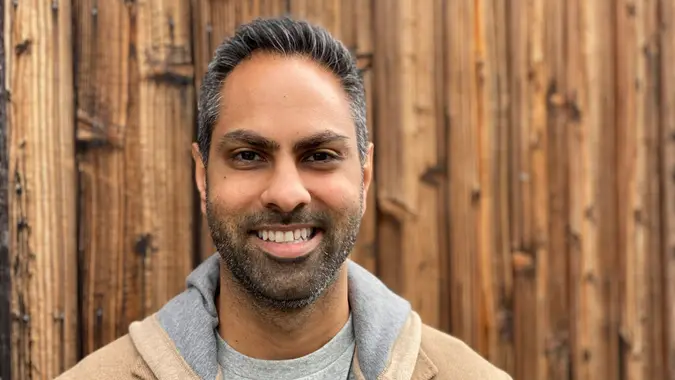Here’s How Much Money Each Generation Plans To Save in 2024

Commitment to Our Readers
GOBankingRates' editorial team is committed to bringing you unbiased reviews and information. We use data-driven methodologies to evaluate financial products and services - our reviews and ratings are not influenced by advertisers. You can read more about our editorial guidelines and our products and services review methodology.

20 Years
Helping You Live Richer

Reviewed
by Experts

Trusted by
Millions of Readers
While pandemic-era stimulus checks provided an opportunity for many people to save money, savings rates have been on a downward trend recently.
In 2020-21, household savings as a percentage of disposable income was nearly 14%. Yet, since 2022, that rate has averaged only around 4%, according to an analysis by New York Fed researchers.
However, many people are more optimistic for 2024. Overall, 47% of Americans surveyed by GOBankingRates say they realistically want to save $5,000 or more in 2024. Considering that the median household income is around $75,000 in the U.S., even just one person in a household saving $5,000 equates to a household savings rate of nearly 7%.
However, savings goals differ by age. Perhaps surprisingly, many young people have lofty savings goals.
Savings Goals by Age
Among those ages 25 to 34, 55% have a savings goal of $5,000 or more, as do 49% of those ages 35 to 44. Among those 55 to 64 — many of whom are likely gearing up for retirement — only 42% plan to save that much.
In other words, people between 25 to 44 (mainly millennials, with Gen Z and Gen X on the fringes) are setting ambitious savings goals, even at a time when they may be juggling competing financial priorities, such as saving for a house and raising children.
But if younger people are serious about savings, it could set them up for success later in life and decrease the pressure to save more later.
“Having adequate savings and retirement investments later in life requires taking proactive steps to get there when you’re in your 20s, 30s, and 40s. The longer you wait to save, the harder it is to catch up,” said Leslie H. Tayne, an attorney and founder of Tayne Law Group, a debt relief law firm. “On the other hand, putting away money early and consistently, even smaller amounts, results in massive growth over time thanks to compound interest.”
That said, it’s not always easy to plan for and reach these goals. On the other end of the spectrum, 42% of people ages 35 to 44 plan to save $3,000 or less in 2024. That’s not quite as common among people ages 45 to 54, among whom 38% have a goal to save $3,000 or less next year.
For Gen Z, saving money can be even more challenging. Among respondents ages 18 to 24, 44% plan to save $3,000 or less next year. That could reflect lower salaries for those early in their careers, but that doesn’t mean saving money shouldn’t be a priority.
“Unfortunately, many young adults see saving money as something that can be put off until they have a higher salary, paid off debt, etc.,” Tayne said. “Retirement is a far-off goal that’s hard to conceptualize and plan for when you’re early in your career. Coupled with increased financial burdens brought on by student loan debt, rising interest rates, inflation, and financial crises, many Americans end up in a position where they don’t have enough funds to set aside to retire comfortably.”
However, many people ages 55 to 64 also have savings challenges. Within this group, 46% plan to save $3,000 or less, including 25% who have a goal of saving less than $1,000, the highest proportion among different age groups. That’s likely reflected in the fact that 40% of people in this age group rated their financial situation at the end of 2023 as “struggling, but still getting by” and 11% said it’s “the worst it has ever been.”
In comparison, among older boomers — age 65 and over — 33% said they’re struggling and 9% said their financial situation is the worst it’s ever been, so not quite as many are in a difficult spot, though plenty have still had a tough year.
“We’re still experiencing some of the ripple effects of the pandemic, but many of the resources available earlier are gone, including stimulus checks and certain tax cuts,” Tayne said. “Inflation is also much higher than it should be, making it hard for people to afford essential goods like groceries. With interest rates on the rise, those with variable-rate debt also saw their balances grow, placing further pressure on their finances.”
Perhaps one explanation for the difference between those ages 55 to 64 and older boomers is that those 65 and over are far more likely to report planning to put money into high-yield savings accounts, certificates of deposit, and bonds in 2024. Thus, some people in this age group may have already been able to take advantage of high interest rates this past year by earning more interest income, rather than having high interest rates work against them.
Setting Realistic Savings Goals
While having savings goals is typically a good financial practice, it doesn’t do much good to set a goal that you can’t meet. In order to set and stick to realistic savings goals, consider the basics. The specifics can differ a bit based on where you are in life (for example, some older Americans may need to save more to catch up on retirement contributions), but there tend to be some universal best practices.
Setting realistic savings goals “differs somewhat by age but not substantively,” said Sam X Renick, co-creator of children’s financial literacy brand Sammy Rabbit.
What’s important, he said, is to “execute and act on common sense and personal finance fundamentals.”
For example, set aside money for saving and investing before spending, he said.
“Over the years, many people have shared with me that when they get money out of their hands and deposited directly into savings and investments accounts, they never saw it or missed it,” Renick said.
You also should get a handle on other personal finance fundamentals like budgeting, especially if you’re trying to save a higher percentage of your income than most people do. You can’t just say you’ll save 50% of your take-home pay if your rent and car payment take up the other 50%. Otherwise, there’s no room for essentials like groceries, let alone a little fun money.
“Once you know your income, expenses, cash flow, and any challenges or limitations you’re facing financially, it will be easier to set realistic goals based on those numbers,” said Tayne.
Plus, savings goals, like any goal, should be “SMART: Specific, Measurable, Attainable, Relevant, and Timely,” said Tayne.
This means that instead of setting a vague goal of “save more money,” you break it down into specific, actionable steps with a deadline. Studies show that setting SMART goals greatly increases your chance of success.
Lastly, consider breaking your savings goal down into smaller parts to increase the likelihood of success.
“For example, the goal of saving $3,000 in a year can seem very daunting,” Tayne said. “But, if you break that goal into smaller mini-goals, such as saving $250 per month, it feels more manageable. Plus, you’ll hit milestones more often, which can be more psychologically motivating.”
 Written by
Written by  Edited by
Edited by 
























